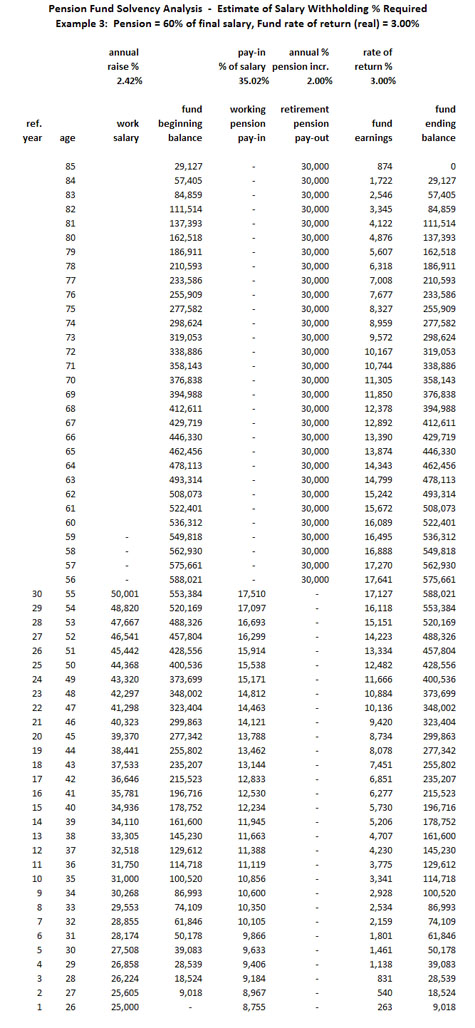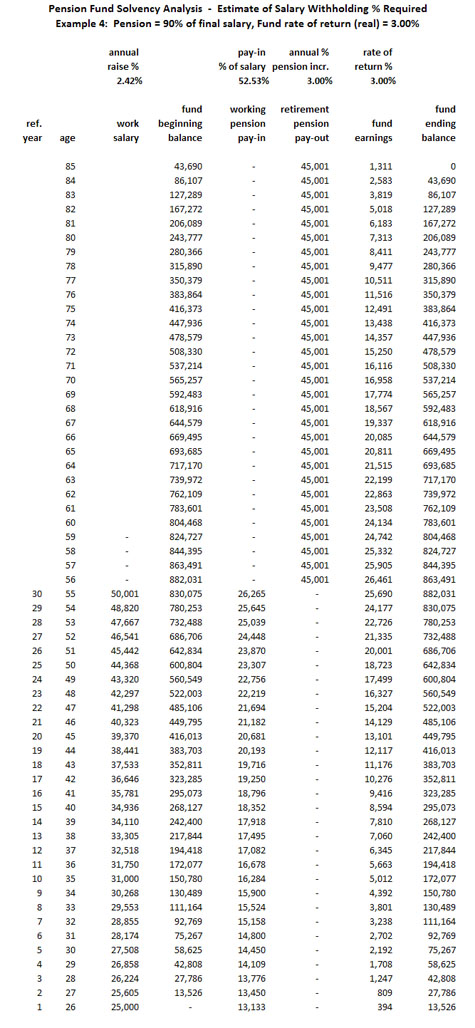Maintaining Pension Solvency
One of the biggest challenges facing governments is determining how to adequately fund present and future pension benefits for their employees. While public employees are working, if a sufficient amount of money is set aside for them each year and invested competently, then by the time the employee retires, their fund balance should be adequate to draw down each month to pay their pension, yet not be fully depleted until after they’ve died. As will be seen, however, unless some very optimistic scenarios are used as the basis for projecting future pension solvency, the amounts that are currently being contributed to public employee pension funds are grossly inadequate.
While the calculation of how much money needs to be set aside each month to build up an adequate pension fund is not simple, it is not so complex or arcane as to defy analysis by policymakers, journalists and commentators, voters, employee advocates, or anyone else concerned with this issue.
In the analysis to follow, four cases are presented, each one calculating what percentage of payroll must be allocated to annual pension funding under various assumptions. These cases concern the pension of a single individual, but when assessing the sustainability of public employee pension benefits, these calculations apply in aggregate as well.
In the four examples below, the same assumptions are made for each individual pension fund chronology – the individual enters public employment at age 25, works until they are 55, and dies at age 85. All calculations and assumptions deal in “real” dollars, meaning that there are no cost of living adjustments either during the worker’s career nor during their retirement. During their career, it is assumed that in real dollars, their annual salary doubled between the time when they started working and the time when they retired, presumably based on merit increases. In one case the employee retires with a pension equivalent to 60% of their final pay – representing the now common “2% per year for 30 years” benefit granted to most non-safety public employees, and in the other case the employee retires with a pension equivalent to 90% of their final pay – representing the now common “3% per year for 30 years” benefit granted to most public employees involved in safety-related occupations. What percent of their salary must be invested each year to make certain their pension will remain solvent until they are 85 years old?
With these assumptions thus made, there is only one variable left to consider, which is the projected long-term real rate of return of the pension fund investments. For each example, I’ve used two rates of return, one provided by David Lamoureux from CalPERS, which is currently the rate they use in their projections, and one somewhat lower rate which I believe to be a more realistic rate. Here is what Lamoureux wrote in response to my inquiry regarding their pension projections: “Our assumption is composed of a 3% inflation and a 4.75% real return for a total of 7.75%.”
Since this analysis excludes inflation in the pension pay-ins and pay-outs (i.e., no COLAs), the rate of return on the fund we’ll start with is 4.75%. This is what CalPERS currently projects as the rate, after lowering returns for inflation, they believe they can sustain over the next several decades.
Each of the examples summarized here are shown on spreadsheets following the text of this analysis. The reader is encouraged to check these spreadsheets and verify the calculations. Here is the summary of what we found:
(1) At a real rate of return of 4.75% per year, a worker would need to set aside an additional 21% of their salary each year for 30 years, in order to enjoy a pension benefit during a 30 year retirement equivalent to 60% of their paycheck.
(2) At a real rate of return of 4.75% per year, a worker would need to set aside an additional 32% of their salary each year for 30 years, in order to enjoy a pension benefit during a 30 year retirement equivalent to 90% of their paycheck.
(3) At a real rate of return of 3.00% per year, a worker would need to set aside an additional 35% of their salary each year for 30 years, in order to enjoy a pension benefit during a 30 year retirement equivalent to 60% of their paycheck.
(4) At a real rate of return of 3.00% per year, a worker would need to set aside an additional 52% of their salary each year for 30 years, in order to enjoy a pension benefit during a 30 year retirement equivalent to 90% of their paycheck.
Several points bear mention here. First of all, other than the rates of return – we’ll come back to those – these are all very conservative assumptions. The spreadsheet formulas are constructed, for example, to calculate interest on annual contributions for the entire year in which each of them are made, even though contributions occur gradually over the course of the year. Similarly, interest is calculated on the fund’s entire ending balance of each preceding year during the retirement phase, even though that balance is declining steadily throughout each retirement year to pay the monthly pensions. Without dissecting the entire spreadsheet, these examples are meant to emphasize the formulas are constructed to present the best possible case. As for the assumptions themselves, what if the pension recipients live, on average, longer than 85 years? Since a significant number of pensions pay the surviving spouse once the primary beneficiary is deceased, and since medical technology, thankfully, continues to advance, it is likely an average life expectancy of 85 is on the low side. What if workers retire before age 55, something fairly common, which increases the length of their projected retirement? What if they work more than 30 years, increasing their payout calculation? Moreover, no impact of pension “spiking” is considered in this analysis, where a worker’s final year of earnings (upon which the pension benefit is calculated) is sharply increased to a level not representative of their earnings growth over the course of their career.
With all this in mind, policy advocates and public administrators should ask themselves: Are we contributing at least 21% per year of our non-safety employees payroll to their pension fund? Are we contributing at least 32% per year of our safety employees payroll to their pension fund? Because that is the absolute best case in terms of what it will take to keep their pensions solvent. It is important to emphasize that retirement pensions are not the only financial obligations taken on by public employers to their retirees – often lifetime medical benefits are included, and the costs to fund these future benefits during the working years of public employees must be evaluated using the same methodology presented here for pensions. This will add several additional percentage points to what amount of payroll must be set aside each year for future benefits.
Returning to the issue of return on investment is crucial, of course. If CalPERS, for example, could earn a real rate of return of, say, 8.0% per year, the annual payment obligations to fund future retirements would be greatly diminished relative to the numbers here. But 4.75% per year is not a conservative projection, it is probably a very best case, because funds this big cannot expect to outperform the growth of the economies in which they invest. Pension funds that in aggregate manage literally trillions of dollars in assets should not expect to earn real rates of return exceeding the rate of global economic growth.
To put this in a historical perspective, global GDP grew at an annual rate of 1.0% or less until the industrial revolution, which increased growth to around 2.0% per year until about 1950. During the period from 1950 to 2000, the rate of global economic growth increased dramatically, to an average annual rate of nearly 4.0%, as the industrial revolution went global, catalyzed further by information technology. But in recent decades, part of the reason for higher rates of global economic growth was the accumulation of unsustainable levels of debt. It is going to take several years – if not decades – for this to unwind, and until there is light at the end of the tunnel, it is imprudent to project more than a 3.0% inflation-adjusted long-term rate of return for massive pension fund investments.
This begs an even more ominous question our public administrators must ask themselves, heralded not on rhetoric but on transparent calculations and cold reality: Are we contributing at least 35% per year of our non-safety employees payroll to our pension fund? Are we contributing at least 52% per year of our safety employees payroll to their pension fund? Not including what we must also set aside for retirement medical coverages? Because in the world we’re living in, with most public employee pension asset values already well below safe levels, that is what it will probably take to keep their pensions solvent.

Edward Ring is a contributing editor and senior fellow with the California Policy Center, which he co-founded in 2013 and served as its first president. He is also a senior fellow with the Center for American Greatness, and a regular contributor to the California Globe. His work has appeared in the Los Angeles Times, the Wall Street Journal, the Economist, Forbes, and other media outlets.
To help support more content and policy analysis like this, please click here.





The pensions funds, while good in paper don’t work in real life. The real problem I see is that people still want the government to support them, and the government doesn’t want to do this anymore.
The solution is to start learning about money and prepare for your own future, save and invest and do not expect anyone else to look after you in your old age.
@Rick, You’re absolutely right about these funds. In government “funds” get used and “repurposed” all the time by politicians who don’t think long term.
Using common sense What do you think is the first thing which will be done when a company gets in trouble?
If you guessed “raid the pension” and tell the employees it’s “to save the company and their jobs” you’re absolutely right.
Trusting someone else with your financial welfare is financial suicide. We have big problems with lack of financial education and even bigger problems with lack of accountability in this country.